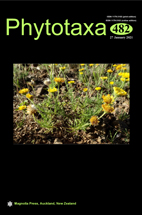Abstract
The genus Sohmaea H.Ohashi & K.Ohashi (2018: 159) is characterized by predominantly linear loments with narrowly oblong-elliptic articles and comprises eight species, distributed in India through SE Asia to China and Taiwan (Ohashi & Ohashi 2018, Ohashi et al. 2018). The name Uraria barbata Lace (1915: 397) was described based on several gatherings from Myanmar. The proposed name U. barbata Lace was preoccupied for U. barbata (Linnaeus 1759: 1170) Desvaux (1826: 309) and thus, U. barbata Lace is a later homonym of the U. barbata (Linnaeus) Desvaux. Therefore, Iokawa et al. (2004: 226) proposed a replacement name U. barbaticaulis for U. barbata Lace. Later, Ohashi et al. (2018: 305) transferred the name U. barbaticaulis to Sohmaea barbaticaulis (Iokawa, T.Nemoto, J.Murata & H.Ohashi) H.Ohashi & K.Ohashi based on the phylogenetic study. The species is characterized by stems barbate, leaves dimorphic with 1-foliolate leaves in the upper portion and pinnately 3-foliolate leaves in the lower portion or 1-foliolate leaves throughout, leaflets large ovate, inflorescences axillary or terminal, pseudoracemes, fasciculate, (1 or) 2–4 per axil, flowers in clusters of 3–12 per node, loments plicate, hooked hairy (Iokawa et al. 2004, Ohashi et al. 2018, Tokaew et al. 2020). The species was earlier thought to be endemic to Myanmar until its new record from Thailand in 2020 (Lace 1915, De Haas et al. 1980, Kumar & Sane 2003, Iokawa et al. 2004, Tokaew et al. 2020), but being a rare species it is worthy of in situ monitoring for its conservation (Maxted et al. 2001, Marod & Kutintara 2012, Kawada et al. 2020, Murray et al. 2020, Perrino & Perrino 2020).

